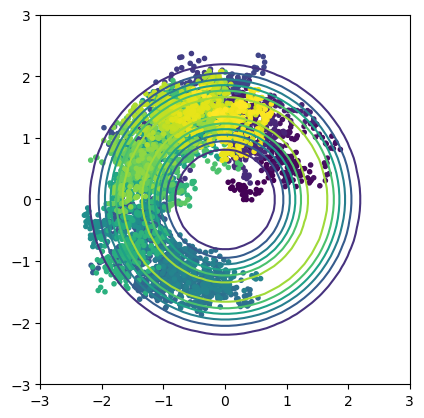9. Stochastic Methods: Exercise Solutions#
import numpy as np
import matplotlib.pyplot as plt
%matplotlib inline
1. Integration#
When an explicit function like \(x_n = g(x_1,...,x_{n-1})\) is not available, you can use a binary function that takes 1 within and 0 outside of a region to measure its volume.
Measure the volume of an n-dimensional sphere using a binary function $\( f(x) = \left\{ \begin{array}{ccc} 1 & \mbox{if} & \sum_{i=1}^n x_i^2 \le 1 \\ 0 & \mbox{otherwise} & \end{array}\right. \)$
from scipy.special import gamma
m = 10000
N = 15
x = np.random.random((N, m)) # one quadrant
vol = np.zeros((N+1, 3)) # estimate by two methods
for n in range(2, N+1):
# by height
h2 = 1 - np.sum(x[:n-1]**2, axis=0)
vol[n,0] = 2**n*np.sum(np.sqrt((h2>0)*h2))/m
# by in/out
r = np.sum(x[:n]**2, axis=0)
vol[n,1] = 2**n*np.sum(r<=1)/m
# theoretical value
vol[n,2] = 2*np.pi**(n/2)/gamma(n/2)/n
print(vol)
[[0. 0. 0. ]
[0. 0. 0. ]
[3.1285408 3.14 3.14159265]
[4.16492299 4.148 4.1887902 ]
[4.83894976 4.9584 4.9348022 ]
[5.21216736 5.0944 5.26378901]
[5.02590453 5.0432 5.16771278]
[4.54028552 4.5568 4.72476597]
[3.7759345 3.7632 4.05871213]
[2.89225018 2.7136 3.2985089 ]
[1.68888845 2.2528 2.55016404]
[1.43391948 1.024 1.88410388]
[0.73606205 0.4096 1.33526277]
[0.39016811 0. 0.91062875]
[0. 0. 0.59926453]
[0. 0. 0.38144328]]
Measure the area or volume of a shape of your interest by sampling method.
A donut of the hole radius \(r0\) and outer radius \(r1\).
m = 10000
r0 = 2 # hole radius
r1 = 6 # outer radius
R = (r0+r1)/2 # radius of the center of the tube
r = (r1-r0)/2 # radius of the tube
x = np.random.random((3, m)) # to be scaled [r1,r1,r]
d = np.sqrt((r1*x[0])**2 + (r1*x[1])**2) # horizontal distance from center
vol = 8*r1*r1*r*np.sum((d-R)**2 + (r*x[2])**2 <= r**2)/m # within the tube?
print(vol)
321.9264
2. Rejection Sampling#
Let us generate samples from Gamma distribution
$\( p(x; k, \theta) = \frac{1}{\Gamma(k)\theta^k}x^{k-1}e^{-\frac{x}{\theta}} \)\(
with the shape parameter \)k>0\( and the scaling parameter \)\theta\( using the gamma function \)\Gamma(k)$ available in scipy.special.
from scipy.special import gamma
from scipy.special import factorial
Here is how the gamma function looks like, together with factorial at integer values.
kmax = 5
x = np.linspace(0, kmax, 50)
plt.plot(x, gamma(x))
plt.plot(range(1,kmax+1), [factorial(k-1) for k in range(1,kmax+1)], 'o')
plt.xlabel('x'); plt.ylabel('gamma(x)');

Define the Gamma density function with arbitrary \(k\) and \(\theta\).
def p_gamma(x, k=1, theta=1):
"""density function of gamma distribution"""
return(x**(k-1)*np.exp(-x/theta)/(gamma(k)*theta**k))
Consider the exponential distribution \(q(x;\mu)=\frac{1}{\mu}e^{-\frac{x}{\mu}}\) as the proposal distribution.
def p_exp(x, mu=1):
"""density function of exponential distribution"""
return(np.exp(-x/mu)/mu)
def x_exp(n=1, mu=1):
"""sample from exponential distribution"""
y = np.random.random(n) # uniform in [0,1]
return(-mu*np.log(1 - y))
The ratio of the target and proposal distributions is $\( \frac{p(x;k,\theta)}{q(x;\mu)} = \frac{\mu}{\Gamma(k)\theta^k}x^{k-1}e^{(\frac{1}{\mu}-\frac{1}{\theta})x}. \)\( By setting \)\( \frac{d}{dx}\frac{p(x;k,\theta)}{q(x;\mu)} = 0 \)\( we have \)\( \{(k-1)x^{k-2}+(\frac{1}{\mu}-\frac{1}{\theta})x^{k-1}\}e^{(\frac{1}{\mu}-\frac{1}{\theta})x} = 0. \)\( Thus at \)\( x = \frac{(k-1)\mu\theta}{\mu-\theta} \)\( the ratio \)\frac{p(x;k,\theta)}{q(x;\mu)}\( takes the maximum \)\( \frac{\mu^k}{\Gamma(k)\theta}\left(\frac{k-1}{\mu-\theta}\right)^{k-1}e^{1-k}. \)\( 2) What is a good choice of \)\mu\( to satisfy \)p(x)\le cq(x)\( and what is the value of \)c$ for that?
By setting \(\mu=k\theta\), we have \(p(x)\le cq(x)\) with \(c=\frac{k^k}{\Gamma(k)}e^{1-k}\)
Verify that \(cq(x)\) covers \(p(x)\) by plotting them for some \(k\) and \(\theta\).
k = 2.5
theta = 1.5
c = (k**k)/gamma(k)*np.exp(1-k)
x = np.linspace(0, 10, 100)
plt.plot(x, p_gamma(x, k, theta), label='p(x)')
plt.plot(x, c*p_exp(x, k*theta), label='c*q(x)')
plt.xlabel('x'); plt.ylabel('p(x)'); plt.legend();
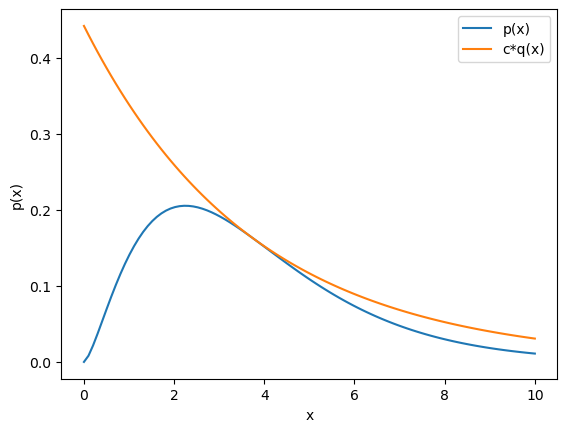
Implement a function to general samples from Gamma distribution with arbitorary \(k\) and \(\theta\) using rejection sampling from exponential distribution.
def x_gamma(n=1, k=1, theta=1):
"""sample from gamma distribution by rejection sampling"""
c = (k**k)/gamma(k)*np.exp(1-k)
#print("c =", c)
xe = x_exp(n, k*theta)
paccept = p_gamma(xe, k, theta)/(c*p_exp(xe, k*theta))
accept = np.random.random(n)<paccept
xg = xe[accept] # rejection sampling
#print("accept rate =", len(xg)/n)
return(xg)
k = 3.5
theta = 1.5
xs = x_gamma(1000, k, theta)
plt.hist(xs, bins=20, density=True)
x = np.linspace(0, 10, 100)
plt.plot(x, p_gamma(x, k, theta))
plt.xlabel('x'); plt.ylabel('p(x)');
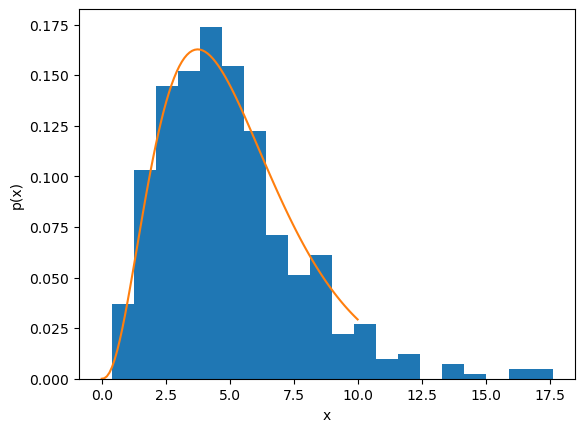
3. Importance Sampling#
You have \(m\) sample values \(f(x_i)\) \((i=1,...m)\) at \(x_i\) following a normal distribution $\( q(x;\mu_0,\sigma_0) = \frac{1}{\sqrt{2\pi \sigma_0^2}}e^{-\frac{(x-\mu_0)^2}{2\sigma_0^2}}. \)$
Consider estimating the mean of \(f(x)\) for samples with a different normal distribution \(p(x;\mu_1, \sigma_1)\) by importance sampling $\( E_p[h(x)] = E_q\left[\frac{p(x)}{q(x)}h(x)\right] \)$
What is the importance weight \(\frac{p(x)}{q(x)}\)?
Let us consider the simplest case of \(f(x)=x\).
Generate \(m=100\) samples with \(\mu_0=100\) and \(\sigma_0=20\) and take the sample mean \(E_q[f(x)]\).
def f(x):
return x
def normal(x, mu=0, sig=1):
"""normal distribution function"""
return np.exp(-((x-mu)/sig)**2/2)/(np.sqrt(2*np.pi)*sig)
m = 100
mu0 = 100
sig0 = 20
xs = mu0 + sig0*np.random.randn(m)
plt.hist(xs, bins=20, density=True)
print(np.mean(f(xs)))
x = np.linspace(mu0-3*sig0, mu0+3*sig0)
plt.plot(x, normal(x, mu0, sig0))
plt.xlabel('x'); plt.ylabel('p(x)');
99.86931648721486
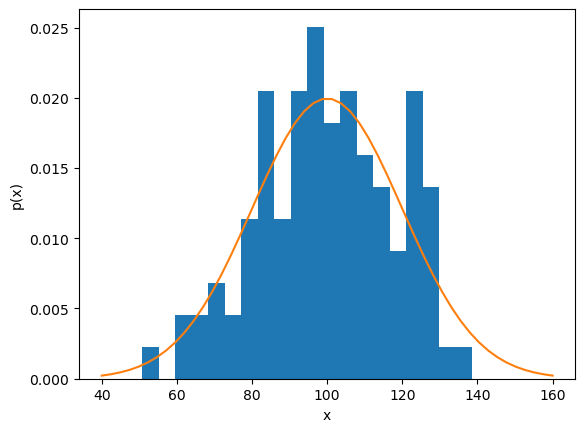
Estimate the mean \(E_p[f(x)]\) for \(\mu_1=120\) and \(\sigma_1=10\) by importance sampling.
mu1 = 120
sig1 = 10
importance = sig0/sig1*np.exp((xs-mu0)**2/(2*sig0**2)-(xs-mu1)**2/(2*sig1**2))
mean1 = np.mean(importance*f(xs))
print(mean1)
plt.hist(xs, bins=20, density=True)
plt.plot(x, normal(x, mu0, sig0))
plt.plot(x, normal(x, mu1, sig1))
plt.plot(xs, importance/100, '*');
plt.xlabel('x'); plt.ylabel('p(x)');
129.36432935592916
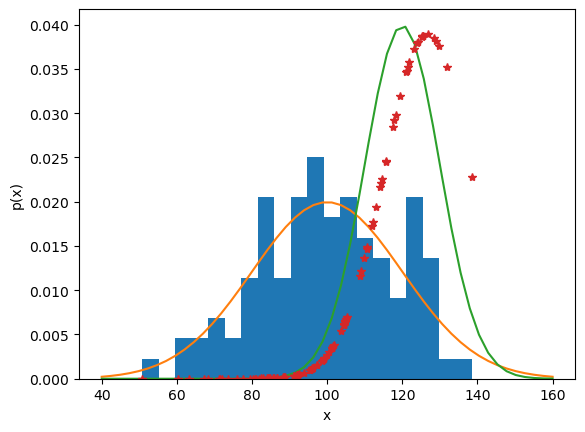
See how the result changes with different settings of \(\mu_1\), \(\sigma_1\) and sample size \(m\).
# more samples
m = 1000
xs = mu0 + sig0*np.random.randn(m)
plt.hist(xs, bins=20, density=True)
print(np.mean(f(xs)))
importance = sig0/sig1*np.exp((xs-mu0)**2/(2*sig0**2)-(xs-mu1)**2/(2*sig1**2))
mean1 = np.mean(importance*f(xs))
print(mean1)
plt.plot(x, normal(x, mu0, sig0))
plt.plot(x, normal(x, mu1, sig1))
plt.plot(xs, importance/100, '*');
plt.xlabel('x'); plt.ylabel('p(x)');
99.69622845174572
113.96548161998948
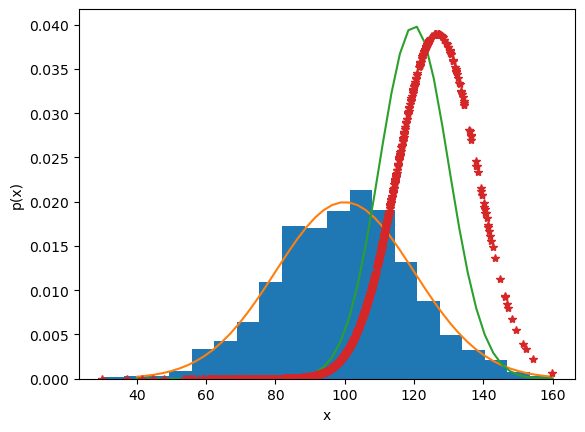
# closer distribution
m = 1000
mu1 = 110
xs = mu0 + sig0*np.random.randn(m)
plt.hist(xs, bins=20, density=True)
print(np.mean(f(xs)))
importance = sig0/sig1*np.exp((xs-mu0)**2/(2*sig0**2)-(xs-mu1)**2/(2*sig1**2))
mean1 = np.mean(importance*f(xs))
print(mean1)
plt.plot(x, normal(x, mu0, sig0))
plt.plot(x, normal(x, mu1, sig1))
plt.plot(xs, importance/100, '*');
plt.xlabel('x'); plt.ylabel('p(x)');
98.97022146821269
108.67226660832513
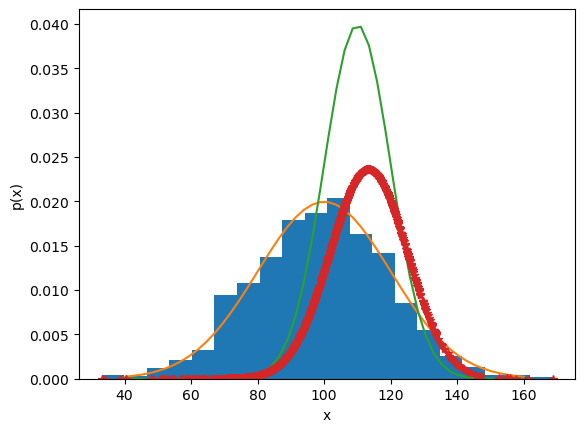
Optional) Try with a different function \(f(x)\).
4. MCMC#
Try applying Metropolis sampling to your own (unnormalized) distribution.
def metropolis(p, x0, sig=0.1, m=1000):
"""metropolis: Metropolis sampling
p:unnormalized probability, x0:initial point,
sif:sd of proposal distribution, m:number of sampling"""
n = len(x0) # dimension
p0 = p(x0)
x = []
for i in range(m):
x1 = x0 + sig*np.random.randn(n)
p1 = p(x1)
pacc = min(1, p1/p0)
if np.random.rand()<pacc:
x.append(x1)
x0 = x1
p0 = p1
return np.array(x)
def donut(x, r0=1, r1=2):
"""donut-like distribution: r0:hole radius, r1:outer radius"""
R = (r0+r1)/2 # radius of the center of the tube
r = (r1-r0)/2 # radius of the tube
d = np.sqrt(x[0]**2 + x[1]**2) # horizontal distance from center
#return np.sqrt((d>r0)*(d<r1)*(r**2-(d-R)**2))
return np.exp(-((d-R)/r)**2)
rx = 3 # plot rage
x = np.linspace(-rx, rx)
X, Y = np.meshgrid(x, x)
Z = donut(np.array([X,Y]))
plt.contour(X, Y, Z)
plt.axis('square')
(np.float64(-3.0), np.float64(3.0), np.float64(-3.0), np.float64(3.0))
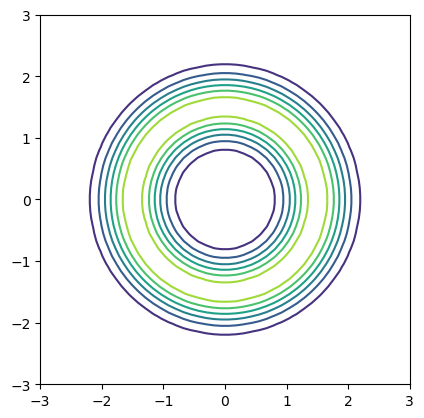
x = metropolis(donut, [0,0], m=5000)
s = len(x); print(s)
plt.contour(X, Y, Z)
plt.scatter(x[:,0], x[:,1], c=np.arange(s), marker='.');
plt.axis('square')
4559
(np.float64(-3.0), np.float64(3.0), np.float64(-3.0), np.float64(3.0))
